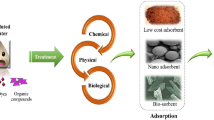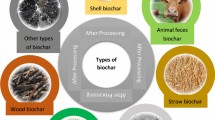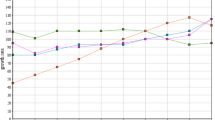Abstract
Treatment of industrial wastewater by electrocoagulation (EC) is one of the most efficient methods to remove pollutants. Paper-recycling wastewater is a complex mixture containing toxic and recalcitrant substances, indicating complexity and difficulty of its treatment. The aim of the present study was to assess the effectiveness of paper-recycling wastewater treatment by EC process using aluminum (Al) and iron (Fe) plate electrodes. Removal of chemical oxygen demand (COD), total suspended solids (TSS), color and ammonia from paper-recycling mill effluent was evaluated at various electrolysis times (10–60 min), voltage (4–13 V) and pH (3.5–11). The optimum process conditions for the maximum removal of COD, TSS, color and ammonia from paper-recycling industry wastewater have been found to be pH value of 7, treatment time of 60 min and voltage of 10 V. Under optimum operating conditions, the removal capacities of COD, TSS, color and ammonia were 79.5%, 83.4%, 98.5% and 85.3%, respectively. It can be concluded that EC could be considered as an effective alternative for treatment of paper-recycling wastewater.





Similar content being viewed by others

References
Ali M, Sreekrishnan T. Aquatic toxicity from pulp and paper mill effluents: a review. Adv Environ Res. 2001;5(2):175–96.
Kamali M, Khodaparast Z. Review on recent developments on pulp and paper mill wastewater treatment. Ecotoxicol Environ Saf. 2015;114:326–42.
Rintala JA, Puhakka JA. Anaerobic treatment in pulp-and paper-mill waste management: a review. Bioresour Technol. 1994;47(1):1–18.
Ashrafi O, Yerushalmi L, Haghighat F. Wastewater treatment in the pulp-and-paper industry: a review of treatment processes and the associated greenhouse gas emission. J Environ Manag. 2015;158:146–57.
Birjandi N, Younesi H, Bahramifar N, Ghafari S, Zinatizadeh AA, Sethupathi S. Optimization of coagulation-flocculation treatment on paper-recycling wastewater: application of response surface methodology. J Environ Sci Health A. 2013;48(12):1573–82.
Latorre A, Malmqvist A, Lacorte S, Welander T, Barceló D. Evaluation of the treatment efficiencies of paper mill whitewaters in terms of organic composition and toxicity. Environ Pollut. 2007;147(3):648–55.
Thompson G, Swain J, Kay M, Forster CF. The treatment of pulp and paper mill effluent: a review. Bioresour Technol. 2001;77(3):275–86.
Nagarathnamma R, Bajpai P, Bajpai PK. Studies on decolourization, degradation and detoxification of chlorinated lignin compounds in Kraft bleaching effluents by Ceriporiopsis subvermispora. Process Biochem. 1999;34(9):939–48.
Khansorthong S, Hunsom M. Remediation of wastewater from pulp and paper mill industry by the electrochemical technique. Chem Eng J. 2009;151(1–3):228–34.
Shen Z, Yang J, Hu X, Lei Y, Ji X, Jia J, et al. Dual electrodes oxidation of dye wastewater with gas diffusion cathode. Environ Sci Technol. 2005;39(6):1819–26.
Bazrafshan E, Mohammadi L, Ansari-Moghaddam A, Mahvi AH. Heavy metals removal from aqueous environments by electrocoagulation process–a systematic review. J Environ Health Sci Eng. 2015;13(1):74.
Mansoorian HJ, Mahvi AH, Jafari AJ. Removal of lead and zinc from battery industry wastewater using electrocoagulation process: influence of direct and alternating current by using iron and stainless steel rod electrodes. Sep Purif Technol. 2014;135:165–75.
Espinoza-Quiñones FR, Fornari MMT, Módenes AN, Palácio SM, Trigueros DEG, Borba FH, et al. Electrocoagulation efficiency of the tannery effluent treatment using aluminium electrodes. Water Sci Technol. 2009;60(8):2173–85.
Sahu O, Mazumdar B, Chaudhari P. Treatment of wastewater by electrocoagulation: a review. Environ Sci Pollut Res. 2014;21(4):2397–413.
Tak B-y, Tak BS, Kim YJ, Park YJ, Yoon YH, Min GH. Optimization of color and COD removal from livestock wastewater by electrocoagulation process: application of box–Behnken design (BBD). J Ind Eng Chem. 2015;28:307–15.
Mansouri K, Hannachi A, Abdel-Wahab A, Bensalah N. Electrochemically dissolved aluminum coagulants for the removal of natural organic matter from synthetic and real industrial wastewaters. Ind Eng Chem Res. 2012;51(5):2428–37.
Mahvi A, Mansoorian H, Rajabizadeh A. Performance evaluation of electrocoagulation process for removal of sulphate from aqueous environments using plate aluminum electrodes. World Appl Sci J. 2009;7(12):1526–33.
Malakootian M, Mansoorian H, Moosazadeh M. Performance evaluation of electrocoagulation process using iron-rod electrodes for removing hardness from drinking water. Desalination. 2010;255(1–3):67–71.
Joseph N, Chigozie U. Effective decolorization of eriochrome black T, furschin basic and malachite green dyes from synthetic wastewater by electrocoag-nanofiltration. Chem Proc Eng Res. 2014;21:98–106.
Can O, Bayramoglu M, Kobya M. Decolorization of reactive dye solutions by electrocoagulation using aluminum electrodes. Ind Eng Chem Res. 2003;42(14):3391–6.
Mollah MYA, Schennach R, Parga JR, Cocke DL. Electrocoagulation (EC)—science and applications. J Hazard Mater. 2001;84(1):29–41.
Omwene P, Kobya M. Treatment of domestic wastewater phosphate by electrocoagulation using Fe and Al electrodes: a comparative study. Process Saf Environ Prot. 2018;116:34–51.
Palahouane B, Drouiche N, Aoudj S, Bensadok K. Cost-effective electrocoagulation process for the remediation of fluoride from pretreated photovoltaic wastewater. J Ind Eng Chem. 2015;22:127–31.
Sharma AK, Chopra A. Influence of operating conditions on the electrolytic treatment for the removal of color, TSS, hardness and alkalinity using Al-Al electrode combination. JANS. 2014;6(1):279–85.
Ilhan F, Kurt U, Apaydin O, Gonullu MT. Treatment of leachate by electrocoagulation using aluminum and iron electrodes. J Hazard Mater. 2008;154(1–3):381–9.
Bazrafshan E, Mahvi AH. Textile wastewater treatment by electrocoagulation process using aluminum electrodes. IJHS. 2014;2(1):16–29.
Vlyssides A, et al. Electrochemical oxidation of a textile dye wastewater using a Pt/Ti electrode. J Hazard Mater. 1999;70(1–2):41–52.
Parga JR, et al. Arsenic removal via electrocoagulation from heavy metal contaminated groundwater in La Comarca Lagunera Mexico. J Hazard Mater. 2005;124(1–3):247–54.
Bazrafshan E, et al. Performance evaluation of electrocoagulation process for removal of chromium (VI) from synthetic chromium solutions using iron and aluminum electrodes. Turk J Eng Environ Sci. 2008;32(2):59–66.
Nouri J, Mahvi A, Bazrafshan E. Application of electrocoagulation process in removal of zinc and copper from aqueous solutions by aluminum electrodes. Int J Environ Res. 2010;4(2):201–8.
Un UT, Koparal AS, Ogutveren UB. Electrocoagulation of vegetable oil refinery wastewater using aluminum electrodes. J Environ Manag. 2009;90(1):428–33.
Bazrafshan E, et al. Application of electrocoagulation process for dairy wastewater treatment. J Chem. 2013:2012.
Alizadeh M, Mahvi AH, Mansoorian HJ. The survey of electrocoagulation process for removal dye reactive Orange 16 from aqueous solutions using sacrificial iron electrodes. IJHSE. 2014;1(1):1–8.
Adhoum N, Monser L. Decolourization and removal of phenolic compounds from olive mill wastewater by electrocoagulation. Chem Eng Process Process Intensif. 2004;43(10):1281–7.
Shankar R, Singh L, Mondal P, Chand S. Removal of COD, TOC, and color from pulp and paper industry wastewater through electrocoagulation. Desalin Water Treat. 2014;52(40–42):7711–22.
Sridhar R, Sivakumar V, Prince Immanuel V, Prakash Maran J. Treatment of pulp and paper industry bleaching effluent by electrocoagulant process. J Hazard Mater. 2011;186(2–3):1495–502.
Mahesh S, Prasad B, Mall ID, Mishra IM. Electro chemical degradation of pulp and paper mill wastewater. Part 1. COD and color removal. Ind Eng Chem Res. 2006;45(8):2830–9.
Uğurlu M, Gürses A, Doğar Ç, Yalçın M. The removal of lignin and phenol from paper mill effluents by electrocoagulation. J Environ Manag. 2008;87(3):420–8.
Espinoza-Quiñones FR, Fornari MMT, Módenes AN, Palácio SM, da Silva FG Jr, Szymanski N, et al. Pollutant removal from tannery effluent by electrocoagulation. Chem Eng J. 2009;151(1–3):59–65.
Bayramoglu M, Eyvaz M, Kobya M. Treatment of the textile wastewater by electrocoagulation: economical evaluation. Chem Eng J. 2007;128(2–3):155–61.
Khandegar V, Saroha AK. Electrocoagulation for the treatment of textile industry effluent–a review. J Environ Manag. 2013;128:949–63.
Inan H, Dimoglo A, Şimşek H, Karpuzcu M. Olive oil mill wastewater treatment by means of electro-coagulation. Sep Purif Technol. 2004;36(1):23–31.
Bazrafshan E, et al. Performance evaluation of electrocoagulation process for diazinon removal from aqueous environments by using iron electrodes. IJEHSE. 2007;4(2):127–32.
Katal R, Pahlavanzadeh H. Influence of different combinations of aluminum and iron electrode on electrocoagulation efficiency: application to the treatment of paper mill wastewater. Desalination. 2011;265(1–3):199–205.
Federation, W.E, A.P.H. Association. Standard methods for the examination of water and wastewater. Washington, DC: American Public Health Association (APHA); 2005.
Aoudj S, Khelifa A, Drouiche N, Hecini M, Hamitouche H. Electrocoagulation process applied to wastewater containing dyes from textile industry. Chem Eng Process Process Intensif. 2010;49(11):1176–82.
Daneshvar N, Khataee AR, Amani Ghadim AR, Rasoulifard MH. Decolorization of CI acid yellow 23 solution by electrocoagulation process: investigation of operational parameters and evaluation of specific electrical energy consumption (SEEC). J Hazard Mater. 2007;148(3):566–72.
Drouiche N, Aoudj S, Hecini M, Ghaffour N, Lounici H, Mameri N. Study on the treatment of photovoltaic wastewater using electrocoagulation: fluoride removal with aluminium electrodes—characteristics of products. J Hazard Mater. 2009;169(1–3):65–9.
Elazzouzi M, Haboubi K, Elyoubi M. Electrocoagulation flocculation as a low-cost process for pollutants removal from urban wastewater. Chem Eng Res Des. 2017;117:614–26.
Azadi Aghdam M, Kariminia H-R, Safari S. Removal of lignin, COD, and color from pulp and paper wastewater using electrocoagulation. Desalin Water Treat. 2016;57(21):9698–704.
Gürses A, Yalçin M, Doğar C. Electrocoagulation of some reactive dyes: a statistical investigation of some electrochemical variables. Waste Manag. 2002;22(5):491–9.
Chen X, Chen G, Yue PL. Investigation on the electrolysis voltage of electrocoagulation. Chem Eng Sci. 2002;57(13):2449–55.
Chou W-L, Wang C-T, Chang S-Y. Study of COD and turbidity removal from real oxide-CMP wastewater by iron electrocoagulation and the evaluation of specific energy consumption. J Hazard Mater. 2009;168(2–3):1200–7.
Kim T-H, Park C, Shin EB, Kim S. Decolorization of disperse and reactive dyes by continuous electrocoagulation process. Desalination. 2002;150(2):165–75.
Chen G. Electrochemical technologies in wastewater treatment. Sep Purif Technol. 2004;38(1):11–41.
Bayramoglu M, Kobya M, Can OT, Sozbir M. Operating cost analysis of electrocoagulation of textile dye wastewater. Sep Purif Technol. 2004;37(2):117–25.
Holt PK, Barton GW, Wark M, Mitchell CA. A quantitative comparison between chemical dosing and electrocoagulation. Colloids Surf A Physicochem Eng Asp. 2002;211(2–3):233–48.
Bleeke F, Quante G, Winckelmann D, Klöck G. Effect of voltage and electrode material on electroflocculation of Scenedesmus acuminatus. BIOB. 2015;2(1):36.
Rodrigo M, et al. Electrochemical technologies for the regeneration of urban wastewaters. Electrochim Acta. 2010;55(27):8160–4.
Vik EA, Carlson DA, Eikum AS, Gjessing ET. Electrocoagulation of potable water. Water Res. 1984;18(11):1355–60.
Chen G, Chen X, Yue PL. Electrocoagulation and electroflotation of restaurant wastewater. J Environ Eng. 2000;126(9):858–63.
Kobya M, Can OT, Bayramoglu M. Treatment of textile wastewaters by electrocoagulation using iron and aluminum electrodes. J Hazard Mater. 2003;100(1–3):163–78.
El-Ashtoukhy E-S, Amin N, Abdelwahab O. Treatment of paper mill effluents in a batch-stirred electrochemical tank reactor. Chem Eng J. 2009;146(2):205–10.
Mohora E, Rončević S, Agbaba J, Tubić A, Mitić M, Klašnja M, et al. Removal of arsenic from groundwater rich in natural organic matter (NOM) by continuous electrocoagulation/flocculation (ECF). Sep Purif Technol. 2014;136:150–6.
Acknowledgements
This study was financially supported by grant No: 950704 of the Biotechnology Development Council of the Islamic Republic of Iran.
Author information
Authors and Affiliations
Corresponding author
Ethics declarations
Conflict of interest
The authors would like to declare that there is no conflict of interest with this research and in the publication.
Rights and permissions
About this article
Cite this article
Izadi, A., Hosseini, M., Najafpour Darzi, G. et al. Treatment of paper-recycling wastewater by electrocoagulation using aluminum and iron electrodes. J Environ Health Sci Engineer 16, 257–264 (2018). https://doi.org/10.1007/s40201-018-0314-6
Received:
Accepted:
Published:
Issue Date:
DOI: https://doi.org/10.1007/s40201-018-0314-6



